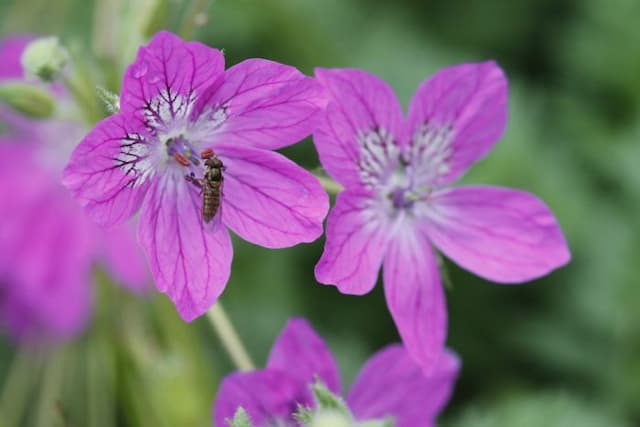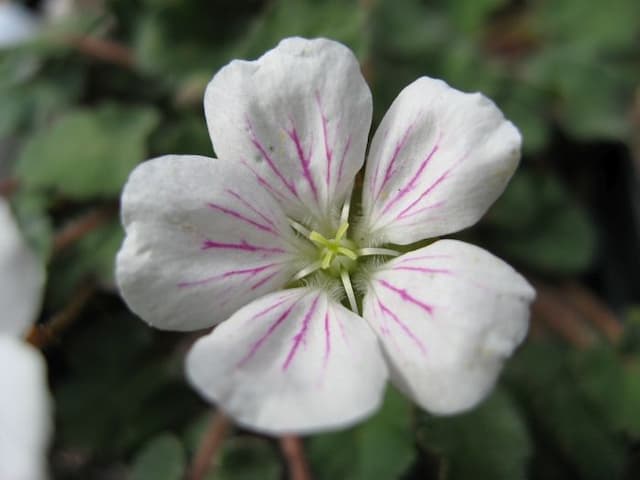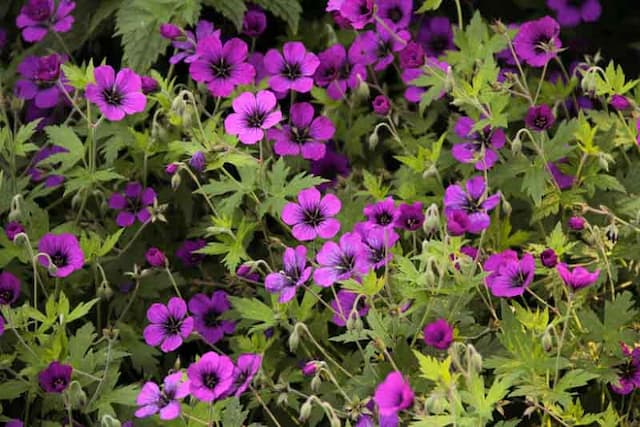Knotted cranesbill Geranium nodosum 'Whiteleaf'

ABOUT
Geranium nodosum 'Whiteleaf' presents a charming display with its delicate, pale green foliage variegated with creamy white margins. The leaves are rounded and deeply lobed, creating a soft-textured look. As a perennial, it comes back year after year with the same reliable beauty. Throughout the blooming period, the plant is adorned with lovely light pink to lilac flowers. These blooms have a classic geranium shape, with five rounded petals and a slightly veined appearance, adding to the overall grace of the plant. The contrast between the variegated leaves and the soft-hued flowers makes 'Whiteleaf' a standout in any garden setting. The plant carries an informal and cottage garden feel and fits well in a border, as a ground cover, or as part of a woodland garden. It is known for its resilience and can bring life to shaded corners of the garden.
About this plant
 Names
NamesFamily
Geraniaceae
Synonyms
Knotted Crane's-bill, Whiteleaf Geranium
Common names
Geranium nodosum 'Whiteleaf'.
 Toxicity
ToxicityTo humans
Geraniums, including Geranium nodosum 'Whiteleaf', are generally considered non-toxic to humans. There are typically no serious symptoms associated with ingesting parts of this plant. However, it is always advisable to prevent the consumption of plants not intended for human consumption to avoid potential stomach discomfort or allergic reactions.
To pets
Geraniums, which include the Geranium nodosum 'Whiteleaf', are typically non-toxic to pets like dogs and cats. Ingesting parts of the plant might cause mild gastrointestinal irritation in some pets, leading to symptoms such as vomiting or diarrhea, but these are not common. It is still best for pets to avoid eating non-food plants to prevent any possible discomfort.
 Characteristics
CharacteristicsLife cycle
Perennials
Foliage type
Deciduous
Color of leaves
Green
Flower color
Pink
Height
1-2 feet (30-60 cm)
Spread
1-2 feet (30-60 cm)
Plant type
Herb
Hardiness zones
5
Native area
Europe
Benefits
 General Benefits
General Benefits- Easy to grow: Geranium nodosum 'Whiteleaf' is widely regarded as a low-maintenance plant suitable for gardeners of all skill levels.
- Shade tolerant: This variety thrives in shaded areas where other plants might struggle, making it ideal for understorey planting.
- Attracts pollinators: The flowers can attract bees and other pollinating insects, supporting local ecosystems.
- Tolerant of different soil types: 'Whiteleaf' can grow in a variety of soil conditions, from moist to well-drained, making it versatile for garden planning.
- Ground cover: Its spreading habit makes it an excellent ground cover, helping to suppress weeds and cover bare spots in the garden.
- Drought resistant: Once established, it has good resistance to drought, reducing the need for frequent watering.
- Long flowering period: Geranium nodosum 'Whiteleaf' often has a longer flowering season, providing a lengthy display of blooms.
- Deer resistant: Generally resistant to deer, which can be a significant advantage in areas where deer predation is a problem.
- Low risk of pests and diseases: It is known for having few problems with pests and diseases, contributing to its ease of care.
 Medical Properties
Medical PropertiesThis plant is not used for medical purposes.
 Air-purifying Qualities
Air-purifying QualitiesThis plant is not specifically known for air purifying qualities.
 Other Uses
Other Uses- Plant dye: The leaves of Geranium nodosum can be used to make a greenish-brown dye for fabric and textiles.
- Educational tool: Geraniums can be used to teach students about pollination and plant biology in a classroom setting.
- Crafts: Pressed or dried geranium leaves can be used in scrapbooking, card making, or other paper crafts for decoration.
- Aromatherapy: The scent of geranium leaves can be infused into oils for use in aromatherapy as a calming agent.
- Culinary garnish: The flowers are edible and can be used as a decorative, albeit non-traditional, garnish in certain dishes.
- Photography: Geraniums are photogenic plants that can be used as subjects or backdrops in botanical photography.
- Companion planting: Geraniums can be planted alongside other plants to create a diverse and attractive garden environment.
- Botanical art: Live geraniums or their parts can be used in the creation of botanical art, such as terrariums or framed plant displays.
- Decorative potpourri: Dried geranium leaves and flowers can be added to potpourri mixes for their subtle fragrance and visual appeal.
- Flower language: Historically, geraniums have been used to convey messages in the language of flowers, where they can symbolize various sentiments.
Interesting Facts
 Feng Shui
Feng ShuiThe plant Geranium is not used in Feng Shui practice.
 Zodiac Sign Compitability
Zodiac Sign CompitabilityThe plant Geranium is not used in astrology practice.
 Plant Symbolism
Plant Symbolism- Unity: Geraniums often symbolize unity or togetherness, making them a good gift for someone with whom you want to express solidarity or a harmonious relationship.
- Friendship: They are also associated with positive relationships and can be given to friends to signify a strong bond.
- Health: The robust nature of geraniums can represent good health and a wish for someone's well-being.
- True Love: In some cultures, geraniums represent true love, signifying deep emotions and long-lasting connection.
 Water
WaterKnotweed cranesbill should be watered regularly, especially during prolonged dry spells. Aim to water deeply once a week, providing about 1 inch of water each time to saturate the soil to the root level. In especially hot or windy conditions, it may require watering twice a week. Avoid overhead watering to prevent leaf diseases, and instead use a soaker hose or drip irrigation. Adjust watering based on rainfall, as over-watering can cause root rot.
 Light
LightKnotweed cranesbill thrives best in partial shade, though it can tolerate full sun in cooler climates. Plant it in a location where it receives morning sunlight and afternoon shade, or dappled light throughout the day. Avoid intense, direct sunlight during the hottest part of the day as it can scorch the leaves.
 Temperature
TemperatureKnotweed cranesbill prefers moderate temperatures and can generally tolerate a range from 30°F to 75°F. The ideal growing conditions are temperatures that consistently remain between 50°F and 70°F. However, it can survive slightly lower temperatures during dormant winter periods but should be protected from frost to prevent damage to the plant.
 Pruning
PruningKnotweed cranesbill should be pruned to encourage bushier growth, remove spent flowers, and maintain a neat appearance. Deadhead regularly by snipping off faded blooms. Perform a more thorough pruning in early spring to remove any old or dead growth and shape the plant. Pruning can also be done after a flush of flowering to rejuvenate the plant and encourage a second bloom.
 Cleaning
CleaningAs needed
 Soil
SoilKnotted Crane's-bill thrives in moist, well-drained soil rich in organic matter with a pH that is neutral to slightly alkaline. A mixture that includes garden loam, peat moss, and perlite in equal parts can provide the balance of drainage and moisture retention ideal for this geranium variety. Amending the soil with compost will ensure a nutrient-rich environment for optimal growth.
 Repotting
RepottingKnotted Crane's-bill should be repotted every 2 to 3 years to refresh the soil and allow space for growth. Check the root system annually; if the roots appear crowded or start to circle the pot, it is time to repot into a slightly larger container.
 Humidity & Misting
Humidity & MistingKnotted Crane's-bill prefers moderate humidity levels, typical of its natural woodland habitat. While it can tolerate some variation, maintaining humidity around 40-50% is ideal for this plant.
 Suitable locations
Suitable locationsIndoor
Bright indirect light, moderate watering, well-draining soil.
Outdoor
Place in partial shade, shelter from intense sun.
Hardiness zone
5-8 USDA
 Life cycle
Life cycleGeranium nodosum 'Whiteleaf', commonly known as the knotted crane's-bill, begins its life cycle as a seed that germinates in spring or early summer in moist, well-drained soil. The seedling emerges and develops into a rosette of leaves at the soil surface. As the plant matures, it forms a clump with upright and occasionally sprawling stems, and it displays its distinct foliage which is often variegated or marked with pale zones. Flowering typically occurs in late spring to summer, showcasing white to pale lilac flowers with veining, which are pollinated by insects. After pollination, the plant produces small, beaked fruits, each containing seeds that disperse when the fruit dehisces or is aided by animal movement. The plant may become dormant in late autumn or winter, especially in colder climates, but it is a perennial and will resume growth from its rootstock with the advent of warmer weather.
 Propogation
PropogationPropogation time
Spring-early summer
The Geranium nodosum 'Whiteleaf', commonly known as the Knotted Crane's-bill, is often propagated through division. This is typically done in spring or autumn. The process involves gently lifting the parent plant from the soil, making sure to keep a good amount of roots attached, and then dividing it into smaller sections. Each section should have at least one shoot and a portion of the root system. The divisions are then replanted at the same depth they were originally growing and watered well. This method encourages quick establishment with minimal stress to the plants, enabling the gardener to increase their stock efficiently.









![Cranesbill [Rothbury Gem]](/_next/image?url=https%3A%2F%2Fplants-admin.emdemapps.com%2Fimages%2Fplants%2F%2Fimages%2F604b6243984c2.png&w=640&q=75)